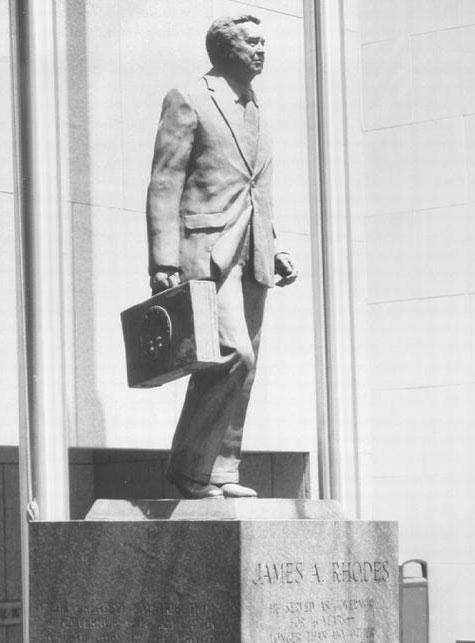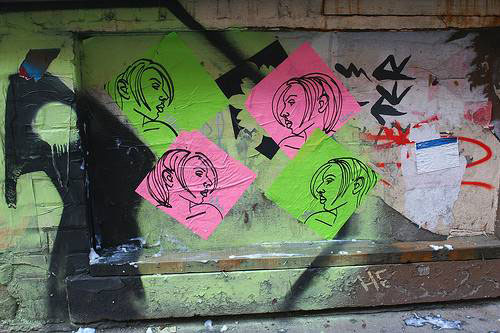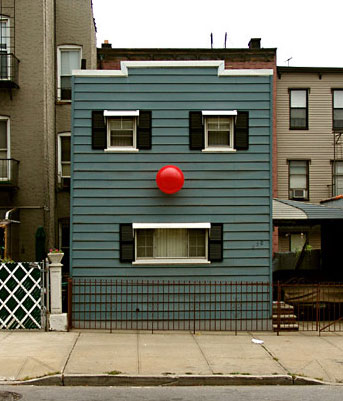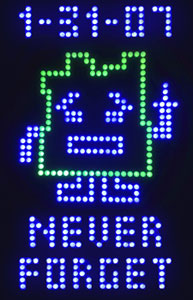

the writing on the wall: what happened to public art?What, exactly, does it mean when a civilization with a continuous 3,000 year-old tradition of public art suddenly dumps that idea for something else? Despite all the revolutions and decays and revivals from the ancients through the medievals to us, the West had acontinuous habit of marking its settlements with images—stone or painted, big or small—of gods, monarchs, holy men, men of state, totemic animals and the occasional airy fantasy. From the remotest antiquity, the tradition was focused through the Greeks, who translated religious art to civic art at the same time they were turning religious rituals into the first dramas. Since then, the intent has never been less than serious. The art was the most virtuosic the community could produce, and the images helped cities and towns forge their identities and their characters. We don't do that anymore. Since the end of the
great twentieth century wars, some strange turn of the western mind has
dissected, deconstructed and sucked meaning out of every form of art,
not to mention music and literature. Public art got the treatment too.
A century ago, Americans would collect around their Civil War monuments
every year to remember the fallen, read a poem and a proclamation, and
maybe sing Dixie or Marching Through Georgia.
We don't do that anymore. Quite suddenly, the daemons and sprites
fled our urban icons, and people stopped looking at them. 1.the city as memo padThe 1960's and 70's weren't just a long strange trip. They were the tipping point of a revolution, one of the deepest changes in life and thought since the beginnings. It's hard to summon up enough perspective to understand just exactly what it meant; that may come in the fullness of time. If we try to analyze the case right now, it looks like this: public art suddenly jumps from the communal to the individual, or corporate. From the strictly referential or allegorical to the nonreferential, or even facetious. From the virtuosic to the ironic. Any attempt to make sense of it all might properly begin with the phenomenon that embodies the rough side of this revolution. All of a sudden, in the 60's, urban Americans started to notice strange new messages on their walls; they called it graffiti. For graffiti's foundations, you might as well look back to the examples that turn up in the archaeological digs of Rome and Pompeii, or even further, to the writing on the wall of Belshazzar's palace—mene mene tekel upharsin... (so God himself, or one of his angels, was the first graffiti artist). People have been scrawling on walls ever since, but the explosion in our time is something of a mystery. Popular expression followed the lead of advertising. In the early 19th century, merchants and showmen with a message made almost every surface of European and American cities serve as their canvas. Have a look at the oldest photos of the commercial streets of Paris, New York or London, and you'll see this is no exaggeration. In an age of rapidly expanding literacy, the city street came to resemble a printed page. The people wanted their say too. Many of them nurtured a passionate cause or two or three, and the new message-board—the city itself—was there to receive their sentiments. What we now call 'graffiti' was largely limited to political and cultural criticism until the 60's, when the world-wide phenomenon of 'tagging' appeared. Some accounts say it started in Philadelphia, others credit the Bronx, where a Greek kid spraypainted his 'TAKI183' tag on everything in sight and got himself interviewed by the New York Times. This new kind of graffiti, little more than a young man proclaiming 'I am here!' in an outlandish, stylish hand, swept the nation in the 70's. Some observers, following the fashionable ideology of the day, saw it as a real popular revolution in art; freedom and chaos come together as the oppressed youth of the ghetto found a way to express themselves. Norman Mailer wrote a fatuous book about it, called The Faith of Graffiti. Unfortunately, this phenomenon coincided with the Catastrophe, the disintegration of community and civility that blasted America's cities in the postwar decades. As neighborhoods burned, graffiti spread over the surviving buildings like a rash. In Philadelphia and New York, the kids covered the subway cars, the warehouses and factory buildings by the tracks, and eventually the buildings in the city centers, up to a height of seven or eight feet. When I first saw downtown Philadelphia in 1973, grimy scrawlings were laid on so thick they seemed like the stains left behind by some great flood. Some of the arty leftists loved it, but for everyone else, graffiti provided the chilling symbol for urban communities in a state of collapse. The tide turned against it in the 80's and 90's. The 'broken windows' theory taught that this kind of graffiti encouraged crime and social disorganization, and cities went on the warpath against it. New York's subway cleaned itself up by catching and prosecuting taggers, and increasing night security around the yards. Chicago's Mayor Daley Jr. mobilizes cleaning crews to hustle around the clock, seven days a week; they'll dis your name before the paint's even dry. There are still plenty of taggers around, and American-style tagging has spread all over the world. From my experience, you'll find it spread most thickly not in merely poor places, but specifically in places where the poor have been cycled through the social treatment of public housing and permanent welfare programs. In short, tagging has become the badge of a government-created permanent underclass. And city people, rich or poor, know that wherever it predominates, it's no place to go for a stroll at twilight. 2. tunnelvisionWhen someone writes a definitive American urban history, the 1970's is bound to have a pretty fat chapter. If it marked the culmination of the Catastrophe, the scorched decade of ruins and bullets and sadness, it was also a time when the slow and fitful self-healing process really began. It was well under the radar for most people, but in inner cities, the first local development corporations were appearing, along with the first cases of spontaneously recovering neighborhoods ('unslumming' as Jane Jacobs called it). Historic preservation passed from the fringe into the mainstream, while local activists began to successfully oppose some highway plans. Urban renewal and public housing projects met an end. Block parties and downtown festivals sprang up everywhere. Government and business settled on the '1% standard' for adding art to building projects. New forms of street art were appearing everywhere, burrrowing up from some deep layer of the civic soul. None were as ugly and anti-social as tagging; more typical was the urban mural. Walls were getting painted everywhere, by cities trying to 'revitalize' areas stricken by the Catastrophe, or by ethnic neighborhoods simply trying to tell a little of their story to the world passing by. The results ranged from the ambient Pop Art of the time to neo-WPA to avant-garde to pure kitsch. There was plenty to make the urban observer laugh, from little visual jokes with the puckish humor of college-town graffiti, to tours de force like the artist Blue Sky's trompe-l'oeil Tunnelvision, on a bank wall in Columbia, South Carolina. Not all the new decorations were officially sanctioned. Some mural artists worked by night, on a small scale, and even some taggers with an artistic bent began expanding that distinctive style into the pictorial, turning their tags into elaborate works in several colors called 'pieces' (as in 'masterpieces'). In all its forms, the new street art believed in the furtive and ephemeral, like the sweet art students who would faithfully reproduce a Botticelli in chalk on a sidewalk, hoping for a few coins before the next rain washed it all away. This new, underground mode of expression came out of its tunnel as an older one seemed to be passing on. We don't always realize just how shattering those decades were. But now, in the age of rock, traditional ideas of public monumental art that had a continuous pedigree from the Periclean Acropolis to the elegant classicism of Augustus Saint-Gaudens and Daniel Chester French in the City Beautiful era were looked on by many as obsolete. Public art had followed the same trajectory as other arts, towards the abstract and the non-referential. Few citizens ever liked it—when Chicago installed a Picasso in front of city hall, one alderman proposed knocking it down and replacing it with a statue of the Cubs' great third baseman Ernie Banks. 
How low can public art sink? The statue of Governor James A. Rhodes on
the Statehouse grounds in Columbus, Ohio. Before he had even died,
members of his party arranged for this tribute, a cast aluminum statue
of the governor, carrying his cast aluminum briefcase and gazing into
some faraway unclouded aluminum future.
Today, no one can deny that the old top-down model
of embellishment— either statues of replaceable politicians, or
heavy, ambiguous chunks of stone or metal, installed for a hefty fee,
chosen by an arts commission or a corporate committee—is dying.
Maybe it's about time. Public art once meant to educate the
public's taste, to create ideals, to invite citizens to aspire.
We grew up in a shabby age that can only mock such sentiments, and the
abstract sculptures that have been piling up on our downtown street
corners over the last half-century seem to mock too. They tell us there
is no meaning, either in art or in our urban life, and if the tribute
to Governor Rhodes is any indication, they may be right. Many of these
ambiguous chunks (some call them 'plop art') are weak stuff
indeed, bought carelessly by large institutions to fill out that 1%
standard, and we'll undoubtedly get to see a few being carted off
to the scrap heap in our lifetimes. 3. street art
Brooklyn street artist Celso (photo by Jake Dobkin, www.streetsy.com)
As the mighty upheaval that began in the 60's and 70's slish-sloshes back and forth towards equilibrium, an age may come again in which people choose to erect solemn memorials. The Vietnam monument in Washington amply demonstrates that the temptation will always be there. Public art might be a kind of barometer, to give us a reading on the state of our communities. The sort of knick-knacks for which cities and businesses have signed checks in recent years whispers that civic pride and civic interest in the United States may be in short supply. Who'll say it isn't so? In any case, until the more traditional forms of public art find their way again, we can enjoy this episode of ferment and experimentation The revolution has spawned everything from Christo's wrapping-paper to Louise Bourgeois' giant spiders to the new trend for 'environmental sculpture': large installations that we travel through rather than simply observe. In an age obsessed with novelty, such works can appear unforgivably mainstream. Christo no doubt still rakes in bushel-basketfuls of money, but no matter what age you are, he's your dad's art. . In such an age, the only way to avoid obsolescence may be to show a moving target. The big postmodernist thinkers constantly remind us that the revolution is taking us from the enduring to the ephemeral, from the top-down to the bottom-up, from the intentional to the casual. This ain't pop. Pop is entirely top-down, relentlessly intentional (it wants your money now). Instead, it is something small and momentarily unprofitable and real. Some folks thrive on it, most notably the merry band working the night shift on the street. They walk by night, like the taggers of the 70's, but then the streets are a little safer now. They climb up to rooftops and down alleys to leave us little masterpieces for free. This is because, as in most ages, we have too many artists and too few customers, and artists with nothing to do will eventually get up to something. They used to get consumption doing it, as in La Bohème; now they just catch colds while they're out prowling. The street artists' bag of tricks is no longer
limited to spray paint, Now they have incorporated electronic gear,
stencils, stickers, lights and all manner of paraphernalia. Their
canvases, employed usually without permission, are the the rough
surfaces of the city, the blank walls, the alleys, the bridges,
abandoned buildings and rusting sheds. This is where graffiti grows,
and many street artists like to use old taggings as a kind of jangly
background. Ephemeral surfaces such as construction site fences make
obvious targets, though some adventurous types get them up near the
roofs of buildings where you wouldn't think anyone could reach.
Traffic signs become a kind of point-counterpoint. The authorities
proclaim on one side, the artist has his say on the other. As Woody
Guthrie put it, that side was made for you and me. 
—Dan Witz, weather balloon on Meeker Street, Brooklyn
Maybe the best thing about street art is its whimsicality in an age of stultified high seriousness. Dan Witz, a well-known practitioner in New York, calls what he does 'public playfulness', The act of composing it, far from the galleries and art schools, is 'unsupervised play'. Street art is global, and one artist who calls himself Invaderhas made playfulness into a planet-wide running joke. His, small, precise tile mosaics of monsters from the old space invaders video game have colonized cities, from Los Angeles to Mombasa. There is one on the Popes' Palace in Avignon, and one on the famous Hollywood sign. I first noticed the Invaders in Paris, on old buildings in the Beaubourg. That city, predictably, remains a couple of decades behind the times, but Paris does have its charms, in the not-too-posh arondissements, including Monsieur Chat, a cartoon face that grins out at you from the most unlikely places, usually on a high gable wall of old buildings . For the most part, these are not dilettantes with time on their hands; they are working artists trying to make a living, and often, what they do on city walls is partly a way of getting known. They put on exhibitions; they design album covers. Some of their friends film the works and then distribute them in street art film festivals. It is a community that is anonymous on the street, but well connected by the internet, where sites such as www.streetsy.com bring news of new occurrences and new artists around the world across a network that extends as far as Mombasa, Tehran, and even Houston. Already, quite a few street artists have made names for themselves in the art world, such as London's Banksy and D*face, or the Wooster Collective,of New York City. Why shouldn't they? Just as the street can be a small-business incubator for a vendor, who might work his way up to a shopowner some day, so street art provides a way for talented people to get in on the ground floor in the art world. Is it a coincidence that a movement like this would flourish at the same time as the beginnings of the internet? Both, after all are about creating new spaces for expression, and both seem to follow a lot of the same rules. When it was discovered that the web could make money, some very big fish began to appear in the pond. The competition for the city's canvases may end up the same. Technology is already creating possibilities we've never imagined, and many of them will require coordination, many skills, and lots of cash. Here's how futurist Bruce Sterling saw it, in a speech he made to the Rice Design Alliance in Houston back in 1994: And since memory and machine intelligence are cheap as dirt (or cheaper), you can do quite astonishing things with very simple and cheap materials. Concrete for instance. You need no longer have flat featureless sidewalks. You can have extremely arty sidewalks, designer sidewalks, at essentially zero cost. You simply spool the sidewalks out and have a kind of cement graphics plotter work them over as they dry. You then have urban sidewalks with an MC Escher ribbon of subtly varying imagery in them, stretching for whole city blocks.... The same for walls, the same for paint... graphic imagery, arbitrary richness of detail, loses all economic value. If you want to pave the walls around you with a 3D animated rendition of the fevered imaginings of Hieronymus Bosch, it's no problem. We're still waiting for most of these wonders
to appear, but be assured they will, and one day the fundamentals of
embellishing cityscapes may become so relatively cheap that we can
change neighborhoods as easily as we redecorate a room. No doubt some
of the street artists of today will be running the show, but in this
grand convergence, as street art, mainstream art, technology and urban
design all come crashing together, who's going to have the final
say in redecorating our cities—the royal and official muse of the
daytime arts, or the convivial muse of the night? 4.attack of the mooninites
In certain lands, the sun is shining. In the cities, people may walk the streets day or night without fear. Life has the old sweet cadence; if not always peachy, it at least it wears a reassuring veneer of sanity. The United States is not one of these lands. It used to be, and may be again, but everybody knows we're passing through a rough patch right now. We won't mention the rest of the host of troubles that beset the republic, but as a strange coda to this essay on art we offer a tale that seems to be a little parable. The regime is scared. Increasingly corrupt and despised governments, at all levels, nervously try to strengthen their hand by using charges of non-existent crimes and the threat of outright violence against anyone who steps out of line. Although our crime rates are on the upswing once again, most of us realize that in these United States right now we have far more to fear from the authorities than we do from the crooks and the terrorists. The mooninite affairbegan on the last day of January, 2007, when someone called the Boston Police and reported a suspicious object on an I-93 overpass. It turned out to be a foot-square circuit board with some D batteries attached, powering LED lights in the form of a cartoon character named Ignignokt, flipping the bird. He was a 'mooninite' —one, incidentally, who looks a lot like the space invaders that have appeared in their thousands around the world without incident. The Athens of America went ape. I-93 was swiftly closed, while local media began whipping the city into a frenzy. Calls came in reporting other signs, which was no surprise since there were 38 of them in all, and they had already been in place for two weeks. By the afternoon transit stations, bridges, and a dozen roads were closed. The Red Line shut down, and the Coast Guard came steaming up the Charles. State and city politicos rushed to the television studios, reassuring the public that they were doing their jobs manfully, and that the situation, which they had in fact created, was under control. Boston's mayor Thomas 'Mumbles' Menino is a man who could easily pass for Mayor Quincy on the Simpsons. Menino, previously best known for malapropisms, for painting his name in big letters on every paintable piece of city property, and for handling some colossal public cash flows with some mighty big leaks in them, had reached his Giuliani moment of destiny. But along with the politicians, the mainstream media failed to state the obvious. The devices were clearly signs, not bombs; it was evident that they contained no explosives. Fixed by magnets to the bridges, the circuit boards could conceal nothing except perhaps a string of the very tiniest Chinese firecrackers. When even the politicians began to notice a farce was brewing, Mayor Menino tried to cover his embarassment with some mumbled growls and spits. The bloody shirt of anarchism was raised, or at least implied. The mooninites were a despicable hoax, designed to disrupt the city and frighten the good citizens. As for Turner Broadcasting, whose Cartoon Channel had dreamed up the stunt, Menino cried 'corporate greed'. State Attorney General Martha Coakley insisted the signs had 'a very sinister appearance', and Governor Deval Patrick explained: 'It's not funny!' The culprits were relentlessly tracked down—though not until they had spent the morning filming the Boston police making monkeys of themselves. Artists Peter Berdovsky and Sean Stevens, who had been approached by Turner's ad firm for the job, completed Boston's humiliation by stoutly refusing to act like they'd done anything wrong. Confronted by a gang of reporters, the two refused to discuss anything but hairstyles of the 70's. When reporters pressed them, Berdovsky answered only 'That's not a hair question'. In the end, the two copped a plea for a little community service and went on their way. The devices had been installed in nine other cities. In none of these did public authorities act as childishly as in Boston, though Mayor John Street of Philadelphia and Police Superintendent Philip Clines of Chicago did their best. Philadelphia threatened Turner Broadcasting with violations of the zoning code, while Chicago, like a Halsted Street down-and-outer, tried to shake Turner down for a few bits, to reimburse it for the cost of finding and destroying the signboards. Boston too saw the opportunity for some righteous extortion, and Mayor Menino pounced. As a measure of just how scary government can be in times of high paranoia, consider that Turner Broadcasting caved immediately, offering an 'apology', in the American manner, and two million dollars as a present to the Boston and the nation for 'homeland security'. Another public figure who probably read too many Batman comics as a kid is Senator Kennedy, a gentleman from whom we might have expected better. He has lately introduced the Terrorist Hoax Improvements Act of 2007, based in language so vague that it allow any local or federal Dogberry to jump whomever he pleases, either by arrest orlawsuit. The other cities, including New York, San Francisco, Los Angeles, Portland and Seattle, did a little to restore faith in American sanity; no punitive steps were taken. Seattle's sheriff pronounced them 'obviously not a threat', while the police sergeant who spoke to the media in Portland reckoned he might take the signs down if he found them on city property. Americans not yet living in bunkers had a good laugh, while the L.A. Times published a mocking editorial entitled 'Pretty Weak, Boston'. We should probably let this parable settle awhile before we try to figure it out. One thing's clear: the danger of street art becoming too commercialized will have to wait a while. But they'll be back, eventually, because street art has power. There's something in it that seems programmed to provoke the absurd, and in a nation that could use a good laugh, that isn't so bad. In this case, street art managed a direct hit on the dark and vile basilisk that squats at the heart of our national nightmare, and even got a corporation to pay for it. Since the incident, the Athens of America has been trying to forget and return to normalcy. Surviving Ignignokts have already gone for good prices on Ebay. Recently, though, the city has had another chilling brush with terror. This one resulted in the bomb squad exploding one of the city's own traffic counting machines, which some Bolshevik in the streets department had chained to a lamppost. No injuries were reported. |
|